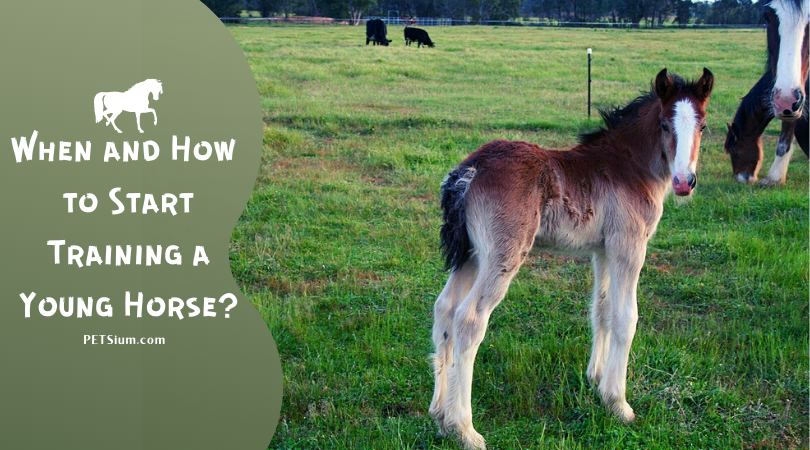The training of a horse starts at the beginning with the foal. Handling begins as early as possible. Believers of this method of handling foals from birth use the concept of foal imprinting. A foal being imprinted will let a human touch it all over, pick up its feet, and become aware of the human voice.
A cute baby horse is called a foal for the first twelve months of his life. The mare carries the foal on average for 335 days. It can be anytime between 320 and 350 days. Usually within an hour the foal is on his feet and trying to suckle from the udder.

Foals that are handled within twelve hours of birth must be treated quietly but also firmly. All foals are different; some are very friendly others are timid and shy.
To catch the foal you will need two people, one to hold the mare while you catch the foal. It can be quite tricky and he may try to escape by going in front or underneath the mare.
He should be caught with one hand around his quarters and the other hand around the front of his chest. Once you have caught him, give him some attention by gently stoking him.
Foals stay close to their mother until approximately six months old, after that they are weaned. Weaning is separating the foal from its mother.
Post Navigation
When it is Best to Start Training the Horse
Horse training is something should start as a foal. You’re probably thinking about some of the horses that start off as two year old without a hand ever being laid on them and they turned out fine. That’s true.
But I would almost bet that even though they never had a hand laid on them their whole life, they’ve also never had a cruel hand laid on them. That’s different.
If a horse is started with cruel treatment it will take a fair amount of kindness and patience to get it over that. With horse training you have to have the patience and affection to give it when needed but you also have to have the wisdom and care to be firm when necessary.
Horse training is like training your kids. They will do what they want if you let them but you have to steer them in ways that are constructive and needed for a good relationship.
There is not a lot of horse training that you can do with a foal that includes a saddle but there is so much more that you can do. I like to start with the horse training as soon as possible.
Teaching a foal to lead is the first I suggest. Making sure that they know you are a friend and not a foe should have already been established. To train a foal to lead you get a small foal halter and place it on them with a long lead.
A long lead is good so that way you can take the excess lead and loop it around their rear (right below their tails but above their hocks) so that way when you pull on their halter it also applies a little pressure to their rear to let them know that it is time to step forward.
While the equine foal is far too young to be ridden, it is still able to learn skills it will need later in life.
By the end of the foal’s first year it should be:
- Well handled
- Foal-slip trained
- Stand tied up
- Halter trained
- Weaned
Foal Handling
An infant pony or horse is known as a foal. By handling the foal you will teach it good manners and it will develop into a horse or pony that respects you but is not afraid of you.
The foal ideally should be handled every day, spending as much time as you can with it. Run your hands all over him, rubbing, scratching and stroking every part of his body.
Handling foal’s legs
When you stroke the legs, start at the shoulder or hindquarters and work your way down. So in other words start from top to bottom.
Lifting the foot
When the foal is used to you touching his legs, try picking up his feet using your voice command saying “up!” Lift the foot a few inches off the floor to begin with.
If the foal struggles with you, hold it gently but firmly until he accepts this. Waite for a second and slowly release the foot.
Each time you practice, try keeping the foot up for a longer period.
Problems lifting a horse’s leg.
It is unnatural for a horse to stand on three legs. It is not uncommon for a horse to plant their legs firmly on the ground and refuse to allow them to be picked up.
Ask a helper to turn the horse’s head in the opposite direction, thus shifting the weight and making it easier and lighter for you to lift the leg.
Safety measures:
- Foal handling must be done with care.
- Some foals are bold, while others are timid.
- Sudden moves might frighten it.
- Stroke a foal; do not pat it, as this will scare it.
- When lifting a leg, horses have been known to rear and also kick out.
Foal-slip Training
While the equestrian foal is far too young to be ridden, it is still able to learn skills it will need later in life. Once the animal is used to you being around it, you can introduce it to a foal-slip, this is also known as a head collar.
Let the foal get used to it first, he may want to sniff at it. A head collar with an adjustable noseband is the easiest to use especially if the animal is nervous.
Place it around the foal’s neck with the lead rope attached, then move it up slowly towards the top of his ears and do it up. Finally fasten the noseband.
Repeat this exercise a couple of times a day until it accepts this as part of a daily routine.
Safety precautions:
- Do not pull on the its head when putting on the head collar. It is easily frightened.
- Never turn it out with a foal-slip on. A foal is curious and can easily get caught up on fences and posts by rubbing and scratching.
Train Foal to Stand Tied Up
At this stage in foal training he should be well handled and familiar with the foal-slip. Firstly tie the mare up so she doesn’t get in the way. Put the head collar on the foal.
Next put the lead rope through the metal ring that should be attached to the stable wall in order to tie the horse up.
Keep the end of the rope in your hand and stand to the back of the foal with your other hand on its quarters, this way you will be able to encourage it to move forward each time it leans back on the rope.
The foal will gradually learn that by taking a step forward it takes pressure off its head. When the foal accepts this tie it up using a quick release knot.
When the foal pulls back on the lead encourage it to go forward by standing near its hindquarters and putting your hand behind it.
Stay with the foal until it is calm. When you decide to leave it, make sure you’re in earshot of it in case there is a problem.
When you untie the foal, make it stand for a short while before you let it go; as you don’t want the foal developing a bad habit like moving off quickly the moment you release it.
- There should be nothing in the stable that can get in the way, like buckets or hay nets.
- The metal ring should be set high enough up the wall in order to prevent foal problems occurring like getting a foreleg over the rope.
- Loop a piece of baling cord to the attached ring first.
Tie to the cord as it is easier to cut in an emergency if you have problems with untying the knot.

Halter Train a Foal
How do I train a foal to lead? The cute foal should be well handled, foal-slip trained and should stand tied up before you teach it to lead.
You will need to put the head collar on the foal and attach a lunge line to it. A lunge line is a very long lead rope, which has many uses.
You will need someone to lead the mare out of the stable and the foal will follow with you holding the line on a light contact and long rein standing some distance behind it, so it remains calm.
The next step is to try and get the foal to stand still and ask the mare to walk on a few feet. When the mare is standing still ask the foal to move forward towards her.
Following on from the above halter training is to teach the foal to lead away from the mare.
It is easier to get someone to help you, as one needs to lead and the other encouraging it forward by putting their hands on its hindquarters.
You can encourage the horse forwards by using a long stick or schooling whip, held behind your back. Remember to use your voice commands first “walk on!” followed by a gentle touch with the stick.
My foal will not move forwards!
If the foal braces itself and you are on your own, stand to its near side holding the lead rope closely to the head collar.
Then take hold of the end of the rope in your right hand and pass it over to the other side, by the foal’s withers allowing the rope to fall down around its hocks.
Slowly take up the slack with your right hand. Encourage it to go forward with your left hand.
If the foal is not responding apply gentle pressure to the lunge line around its hocks. If gentle pressure has no effect you may need to be quite firm.
Safety precautions:
- Train in a quiet area where there are no distractions. If the mare is upset and stressed the foal will react to this situation.
- Never pull, tug or drag the foal, it will end up leaping in the air or running backwards.
Foal Weaning
When a foal reaches the age of six months it is usually separated from its mother.
It is much easier if the foal has been well handled, be able to lead on his own and been introduced to hard feed before it is weaned.
The majority of foals are born in the spring time, so weaning time is most likely to be in the autumn. If the foal is not of a hardy type, it is probably better to bring it in during the night for its first winter.
This will also give you the opportunity to handle it on a regular basis.
If you do decide to keep the foal out at night, a field with shelter is important. You also need to visit the foal at least twice a day.
If the foal is already used to hard feed like foal pellets, then it is less likely to loose condition when taken away from its mother. The foal needs to be brought in to a stable with a quiet companion horse to act as a “nanny”.
They will need to be kept in for at least 24hrs. Afterwards they can be turned out into a small, well-fenced paddock out of earshot of the mare.
If the mare or foal can hear each other, it can be very stressful for both.
If it is not possible to remove the mare out of earshot, then ride the mare out while the foal is shut in with the companion horse. After a week or two the foal and companion can be turned out separately from the mare.
Training a Young Horse
The best way to train anything is to start from the beginning. It’s hard to get a big dog and have it know everything that you want for it to know.
But if you get it as a puppy you can raise it the exact way that you like and make sure that it knows every single thing that you want it to know. It’s the same with horses.
If you start with your horse training with a colt you can make sure that it knows everything that you want it to know before it ever has a saddle on its back.
With horse training a colt you can’t just pull and pull until they come. You have to try the pull and release method.
You tug until they take a step forward and then release them and repeat over and over with praise after a while. It is also good if you can do this with someone else leading their momma so that they really want to follow you.
You can also work on the horse training of your foal by desensitizing it to many of the things it will see when it’s old enough to be saddle trained. Take it for walks when you go trail riding on your horse, take the lead and gently move it around their feet.
You can even take a feed sack or trash bag and rub it all over them to let them know that the weird sound is nothing to worry about. And mess with their heads. Literally. Mess with their ears, inside and out. Rub them as it actually is really relaxing to a horse.
Some might not be lucky enough to get a horse that they can raise from a foal all the way up to riding age to begin their horse training. You might get a horse that is three or four or even ten and hopefully broken in.
These are only some of the few suggestions I have in horse training your foal. They will give you a good head start for when it gets old enough for that saddle.




